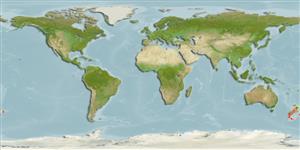Klassifizierung / Names
Namen | Synonyme | Catalog of Fishes(Gattung, Arten) | ITIS | CoL | WoRMS | Cloffa
>
Gadiformes (Cods) >
Macrouridae (Grenadiers or rattails)
Etymology: Coelorinchus: Greek, koilos = a hollow + Greek, rhyngchos = jaw (Ref. 45335).
More on author: Waite.
Environment: milieu / climate zone / Tiefenbereich / distribution range
Ökologie
seewasser benthopelagisch; standorttreu; tiefenbereich 33 - 335 m (Ref. 1371). Subtropical; 37°S - 54°S, 162°E - 172°W (Ref. 1371)
Southwest Pacific: endemic to New Zealand.
Size / Gewicht / Alter
Geschlechtsreife: Lm ? range ? - ? cm
Max length : 34.0 cm TL Männchen/unbestimmt; (Ref. 1371)
Rückenflossenstacheln (insgesamt) : 0; Afterflossenstacheln: 0. Head gently rounded, completely scaled, without strong scute-like ridges and no broad naked areas. Snout rounded, without a sharp point. Light organ lanceolate to narrowly oval, extending forward to midway between the anus and the pelvic fin insertions.
Body shape (shape guide): elongated; Cross section: circular.
Caught by commercial and research vessels.
Life cycle and mating behavior
Geschlechtsreife | Fortpflanzung | Ablaichen | Eier | Fecundity | Larven
Cohen, D.M., T. Inada, T. Iwamoto and N. Scialabba, 1990. FAO species catalogue. Vol. 10. Gadiform fishes of the world (Order Gadiformes). An annotated and illustrated catalogue of cods, hakes, grenadiers and other gadiform fishes known to date. FAO Fish. Synop. 125(10). Rome: FAO. 442 p. (Ref. 1371)
IUCN Rote Liste Status (Ref. 130435: Version 2025-1)
Bedrohung für Menschen
Harmless
Nutzung durch Menschen
Fischereien: weniger kommerziell
Tools
Zusatzinformationen
Download XML
Internet Quellen
Estimates based on models
Preferred temperature (Ref.
123201): 7.7 - 14.6, mean 10.2 °C (based on 35 cells).
Phylogenetic diversity index (Ref.
82804): PD
50 = 0.5000 [Uniqueness, from 0.5 = low to 2.0 = high].
Bayesian length-weight: a=0.00245 (0.00126 - 0.00477), b=3.19 (3.02 - 3.36), in cm total length, based on LWR estimates for this Genus-body shape (Ref.
93245).
Trophic level (Ref.
69278): 3.6 ±0.55 se; based on food items.
Widerstandsfähigkeit (Ref.
120179): niedrig, Verdopplung der Population dauert 4,5 - 14 Jahre. (Preliminary K or Fecundity.).
Fishing Vulnerability (Ref.
59153): Low vulnerability (24 of 100).
🛈
